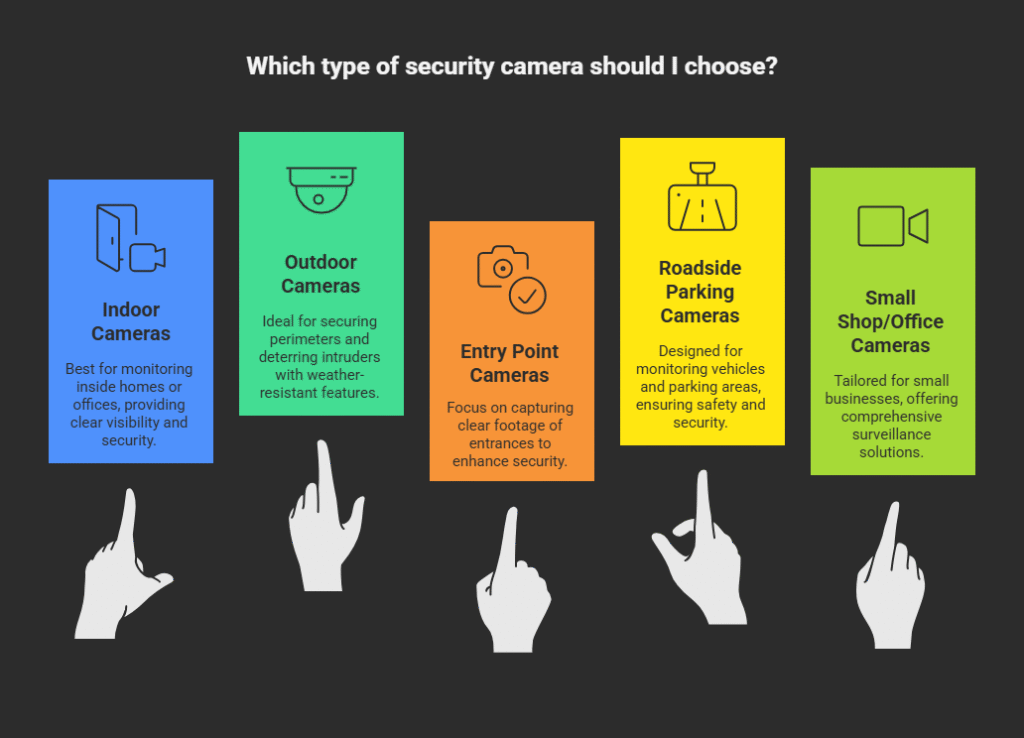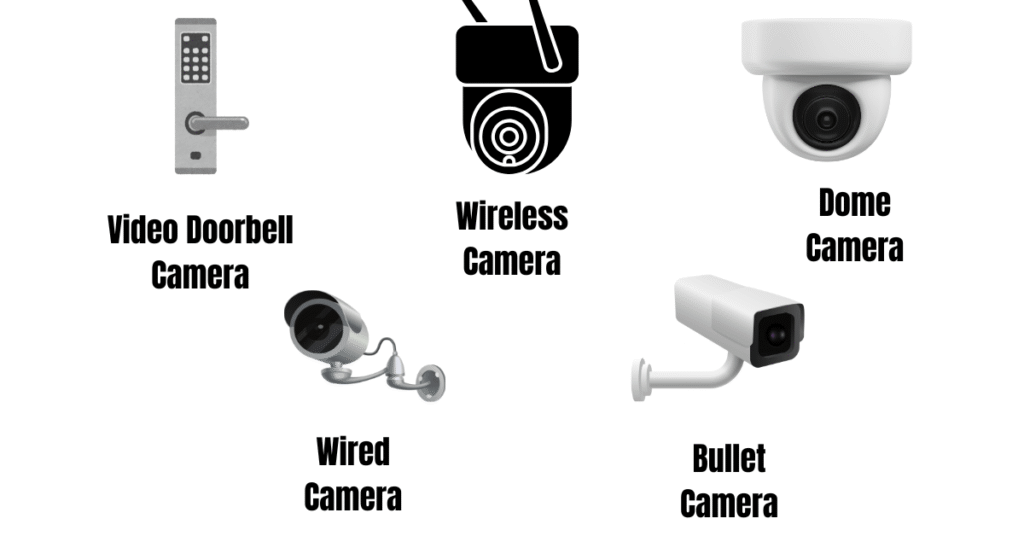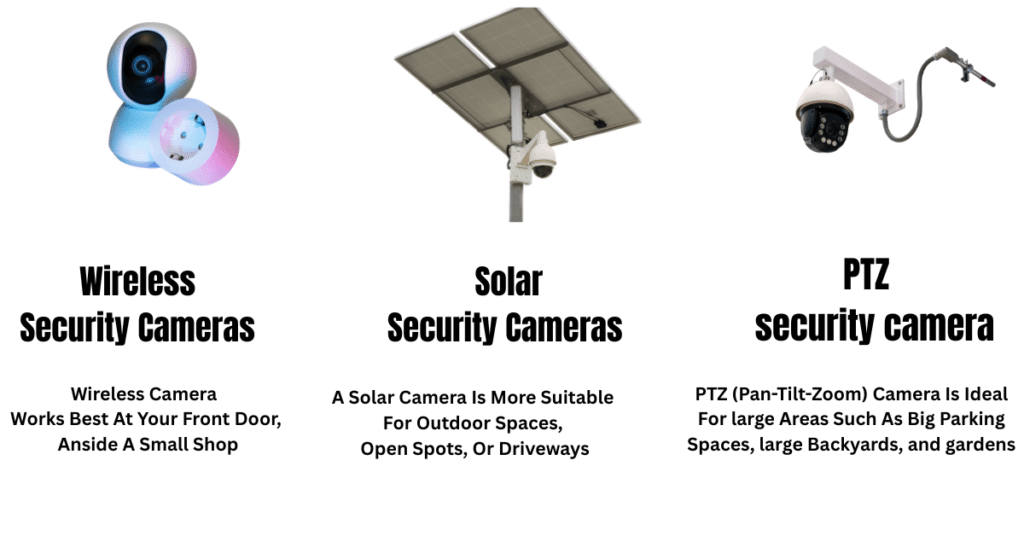Choosing the right security camera setup can feel confusing for many new UK homeowners and small business owners. One of the most common questions I hear is: “Will just 1–4 cameras be enough to protect my home or shop?” After years of studying UK CCTV trends and creating tools like the UK CCTV Installation & Cost Calculator, I realised that most beginners don’t actually need a huge system — a smart 1–4 camera setup can cover almost every important area.

Most Used Security Camera Types for 1–4 Camera Setups in the UK,In the UK, homeowners and small business owners often ask: “Which camera types are best if I only need 1–4 security cameras?” The answer is simple — you don’t need dozens of cameras for reliable protection. With just some of the most commonly used CCTV types — Dome, Bullet, Wireless, And Wired CCTV Cameras, as well as entry-level cameras(For roadside coverage, solar Security Cameras are perfect)— you can easily cover the most important areas in your home, shop, or roadside location.

Choosing Just One Security Camera Based on Your Place
If you’re a homeowner or a small shop owner in the UK and want to start with just one security camera, the right choice really depends on where you need protection the most. For example, a wireless camera works best at your front door, inside a small shop, in the garage, or in other small indoor areas. A solar camera is more suitable for outdoor spaces, open spots, or driveways—especially if you park your car on the street. On the other hand, a PTZ (Pan-Tilt-Zoom) camera is ideal for large areas such as big parking spaces, large backyards, gardens, office or business entrances, and warehouses. The good news is that you don’t need a full system right away—a single, well-chosen camera can provide strong coverage. Below, we’ve created a simple guide to show which type of camera is most effective for different places, along with storage options that are enough for just one camera.

How These Security Cameras Work
Security cameras operate based on a few key components: power, storage, internet connectivity, and video access.
- Power: Wireless cameras usually run on electricity or batteries, while solar cameras charge themselves using sunlight, making them perfect for outdoor areas with no power supply. PTZ cameras typically need a stable power source due to their motorized movement.
- Storage: Video footage can be stored locally on an SD card (common for single cameras) or on a cloud service for remote access and extra security. One camera usually needs only 16–64GB SD card storage for typical home use, depending on recording quality and hours of recording.
- Internet: Most modern cameras require an internet or Wi-Fi connection to enable live streaming, notifications, and remote access via a smartphone or computer. Some solar or wireless cameras can also record offline and sync footage when internet is available.
- Accessing Video Footage: Users can access the recorded or live footage using mobile apps, web portals, or NVR/DVR systems, depending on the camera type. This allows you to monitor your property from anywhere and ensure real-time security.
By understanding these features, even a single camera can provide effective monitoring and peace of mind, tailored to your specific location and needs.
Choosing Just 3–4 Security Cameras Based on Your Place
If you feel that your home or small business needs 3–4 security cameras, the ideal system really depends on the distance between the cameras and the areas you want to cover. When using multiple cameras, you can combine different types depending on your needs.
NVR/DVR Systems for Close-Proximity 3-4 Cameras

If the cameras are placed relatively close together and you want to monitor all of them from a single app or a TV screen, an NVR/DVR system is a great option. These systems connect all cameras to a central recorder, allowing you to store footage on one device and access live or recorded video easily. For 3–4 cameras, a 16–64GB SD card per camera or central NVR storage is usually sufficient for daily recording. This setup works well for small to medium areas like the living room, front door, or shop entrances. More Information: NVR/DVR System.
Expert Tip: When setting up an NVR/DVR system, ensure that the recorder has adequate storage capacity to handle the combined video data from all connected cameras. It’s also essential to configure the system for optimal recording settings to maximize storage efficiency.
📡 3-4 Wireless Cameras for Indoor and Hard-to-Wire Areas
For most homes and small businesses, a 3–4 camera setup is often enough to cover the main security risk areas. Typically, these include the front door, backyard or side entrance, garage/parking area, and one indoor location. Whether this number is enough depends on the layout of your property and the distance between these places.
If the locations are close together, wired cameras may work well. But if the cameras need to be placed far apart and running cables becomes difficult, then wireless security cameras are the more practical option.
If the cameras are far apart indoors—for example, in the garage, hallways, or separate rooms—running cables can be tricky. In this case, wireless security cameras are the best choice, as they can transmit video via Wi-Fi and still allow central monitoring.

Storage Options for Wireless Security Cameras
When using 3–4 wireless cameras, storage can be handled in three main ways:
- Cloud Storage – Footage is uploaded online and can be accessed from anywhere (requires subscription).
- Local Storage (MicroSD Card) – Each camera stores its own recordings, but space is limited.
- Wireless NVR – Collects footage from all cameras in one central device, suitable for small multi-camera setups.
Expert Tip: When choosing wireless cameras, ensure they have a strong Wi-Fi signal range and are compatible with your existing network to avoid connectivity issues.
☀️ Solar-Powered 3-4 Cameras for Outdoor and Remote Areas
For outdoor areas or places far from power outlets, like a backyard, driveway, or garden, connecting multiple wired cameras can become complicated. Here, solar-powered cameras are ideal—they charge using sunlight, operate wirelessly, and can cover wide outdoor spaces efficiently.
Expert Tip: Opt for solar-powered cameras with built-in batteries to ensure continuous operation during cloudy days or at night.
🧠 Expert Advice: Combining Camera Types for Comprehensive Coverage
Even with just 3–4 cameras, mixing camera types—wireless indoor, solar outdoor, and PTZ for large areas—can give you complete coverage without overcomplicating installation. Start with the most vulnerable or high-traffic areas first, then expand if needed.
Expert Tip: Prioritize camera placement based on the most critical areas you wish to monitor, and consider future expansion when selecting camera types and system configurations.
